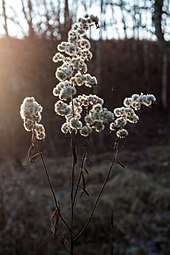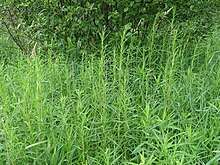Symphyotrichum lanceolatum
Symphyotrichum lanceolatum (syn. Aster lanceolatus) is a species of flowering plant in the family Asteraceae. It is native to North America, and has been introduced to Europe. Common names include panicled aster, tall white aster,[1] eastern line aster, lance-leaf aster, narrow-leaf Michaelmas daisy, and white-panicle aster.[2]
| Symphyotrichum lanceolatum | |
|---|---|
| Scientific classification | |
| Kingdom: | Plantae |
| Clade: | Tracheophytes |
| Clade: | Angiosperms |
| Clade: | Eudicots |
| Clade: | Asterids |
| Order: | Asterales |
| Family: | Asteraceae |
| Genus: | Symphyotrichum |
| Species: | S. lanceolatum |
| Binomial name | |
| Symphyotrichum lanceolatum | |
| Synonyms | |
| |
Description

This perennial herb has a thick, erect stem that often grows 1.5 meters tall or more, sometimes approaching 2 meters. It has a stout rhizome and can spread to form a colony. The leaf blades have winged petioles and may sheath the stem at the bases. The largest, near the base of the plant, are up to about 15 centimeters long. Those higher on the stem are smaller. The lower leaves may have toothed edges. The inflorescence is usually a large, branching array of many flower heads of varying size. There are 16 to 50 ray florets per head, each measuring 3 to 14 millimeters long, in shades of blue, pink, or white. The disc florets bloom yellow and turn purple.[3]
Taxonomy
This species may be divided into two subspecies and five varieties:[3]
- S. lanceolatum subsp. hesperium
- S. lanceolatum var. hesperium - northern Canada, western United States and northwestern Mexico
- S. lanceolatum subsp. lanceolatum
- S. lanceolatum var. hirsuticaule - great lakes region of Canada and the United States
- S. lanceolatum var. interior - eastern Canada and northeastern United States
- S. lanceolatum var. latifolium - eastern Canada and eastern United States
- S. lanceolatum var. lanceolatum - eastern and central Canada and United States, also introduced to Europe
The hybrid of this species with Symphyotrichum novi-belgii, known as Sympyotrichum ×salignum, originates in cultivation but is now naturalised in Europe. Hybrids have also been reported with S. boreale, S. laeve, S. lateriflorum, S. puniceum and S. racemosum.[3]
Symphyotrichum lanceolatum was formerly included in the large genus Aster as Aster lanceolatus. However, this broad circumscription of Aster is polyphyletic and the North American asters are now mostly classified in Symphyotrichum and several other genera.[4]
Distribution and Habitat
Symphyotrichum lanceolatum is native to much of Canada excepting the far north, to most of the United States, and to northwestern Mexico in Baja California, Sonora and Chihuahua.[3] The species has been introduced and naturalised in many parts of Europe, from Belgium to Serbia to Latvia.[5][6][7]
In its native range, Symphyotrichum lanceolatum occurs in a wide variety of mostly moist, open habitats, including riparian areas, meadows and ditches.[3] As an introduced species in Europe, it occurs in disturbed man-made habitats, as well as in riparian areas as an invasive species.[7]
Ecology

In addition to dispersal by wind-blown seed, Symphyotrichum lanceolatum spreads extensively by rhizomes to create large clones. Although these clones do not dominate habitats in North America, growing in association with grasses, goldenrods and other asters[8], in Europe it is an invasive species that excludes native plants in riparian habitats.[5] This invasiveness has been linked to allelopathic compounds in S. lanceolatum tissue, and their effect on native European plants.[5] Viable seed production in Europe seems to be limited, and the species largely spreads there via rhizomes.[7]
The species is visited by a wide variety of pollinating insects, including bees, flies, moths and wasps. Cross-fertilisation is usually required to produce viable seed, and as such large clones may have low seed production.[8]
Several gall midge species are known to form galls on S. lanceolatum, including Rhopalomyia asteriflorae and Asteromyia paniculata. Leaf-mining insects known to feed on this species include Anoplitis inaequalis, Agromyza curvipalpis, Phytomyza albiceps, Microrphopala xerene, and Sumitrosis inaequalis. Younger instars of Gorgone Checkerspot caterpillars will feed on Symphyotrichum lanceolatum.[8]
Uses
Symphyotrichum lanceolatum may be a minor weed in agricultural fields.[8]
Within its native range, the species was used by indigenous peoples for a variety of medicinal purposes. In the American Southwest, the Zuni people used this plant for wounds and nosebleed. The Iroquois in what is now Eastern Canada used it to treat fever.[9]
Symphyotrichum lanceolatum is also cultivated as an ornamental garden plant and may be used in the cut flower industry.[8]
References
| Wikimedia Commons has media related to Symphyotrichum lanceolatum. |
- Dickinson, T., et al. (2004) The ROM Field Guide to Wildflowers of Ontario. Toronto: Royal Ontario Museum. p. 190.
- "Symphyotrichum lanceolatum". Germplasm Resources Information Network (GRIN). Agricultural Research Service (ARS), United States Department of Agriculture (USDA). Retrieved 16 January 2018.
- Brouillet, Luc; Semple, John C.; Allen, Geraldine A.; Chambers, Kenton L.; Sundberg, Scott D. (2006). "Symphyotrichum lanceolatum". In Flora of North America Editorial Committee (ed.). Flora of North America North of Mexico (FNA). 20. New York and Oxford – via eFloras.org, Missouri Botanical Garden, St. Louis, MO & Harvard University Herbaria, Cambridge, MA.
- Semple, J. C. "An overview of "asters" and the Tribe Astereae". University of Waterloo. Retrieved 22 January 2020.
- Nešić, Marija; Obratov-Petković, Dragica; Skočajić, Dragana; Bjedov, Ivana; Đukić, Matilda; Đunisijević-Bojović, Danijela (2016). "Allelopathic potential of the invasive species Aster lanceolatus Willd". Periodicum Biologorum. 118 (1). doi:10.18054/pb.v118i1.2816.
- Gudžinskas, Zigmantas; Petrulaitis, Lukas (2016). "New alien plant species recorded in the southern regions of Latvia". Botanica Lithuanica. 22 (2): 153–160. doi:10.1515/botlit-2016-0016.
- Verloove, Filip. "Symphyotrichum lanceolatum". Manual of the Alien Plants of Belgium. Retrieved 23 January 2020.
- Chmielewski, Jerry G.; Semple, John C. (2001). "The biology of Canadian weeds. 113. Symphyotrichum lanceolatum (Willd.) Nesom [Aster lanceolatus Willd.] and S. lateriflorum (L.) Löve & Löve [Aster lateriflorus (L.) Britt.]". Canadian Journal of Plant Science. 81 (4): 829–849. doi:10.4141/P00-056.
- Symphyotrichum lanceolatum. Native American Ethnobotany. University of Michigan, Dearborn.
External links
- "Symphyotrichum lanceolatum". Natural Resources Conservation Service PLANTS Database. USDA.
